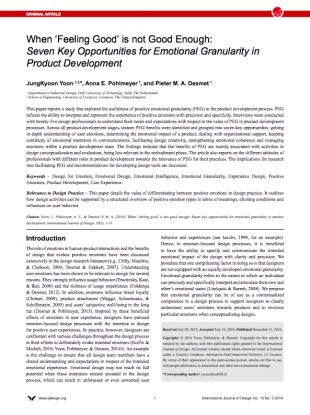This paper reports a study that explored the usefulness of positive emotional granularity (PEG) in the product development process. PEG re ects the ability to interpret and represent the experience of positive emotions with precision and speci city. Interviews were conducted with twenty- ve design professionals to understand their needs and expectations with respect to the value of PEG in product development processes. Across all product development stages, sixteen PEG bene ts were identi ed and grouped into seven key opportunities: getting in-depth understanding of user emotions, determining the emotional impact of a product, dealing with organizational support, keeping continuity of emotional intentions in communications, facilitating design creativity, strengthening emotional coherence and managing emotions within a product development team. The ndings indicate that the bene ts of PEG are mainly associated with activities in design conceptualization and evaluation, being less relevant in the embodiment phase. The article also reports on the different attitudes of professionals with different roles in product development towards the relevance of PEG for their practices. The implications for research into facilitating PEG and recommendations for developing design tools are discussed.
Citation:
Yoon, J., Pohlmeyer, A. E., & Desmet, P. M. A. (2016). When ‘feeling good’ is not good enough: Seven key opportunities for emotional granularity in product development. International Journal of Design, 10(3), 1-15.




